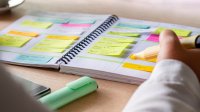How to Get Students to Use Their Planners
Mentally tracking assignments and activities is difficult—here’s a way to guide students to use paper or digital tools to ease that cognitive load.
As the initial excitement of the school year fades, we may notice a pile-up of once-exciting, now-ignored office supplies—student planners among them. While many students have been given or instructed to use a planner, only some have been taught how to use one.
Empowering students to use and benefit from planners takes some strategic teaching, yet the executive function growth (and ease of work management for students and teachers) is well worth the effort. Let’s explore a few strategies to get students to actually use a planner or similar system.
Explore How You Work and Consider Options for Students
Start by thinking backward from the goal: How do planners serve students? Do you personally use a planner, and if so, how? If not, how do you manage your work and schedule? You may find that although you’ve recommended that your students use personal planners, maybe you’ve individualized a system of work management that best serves you—all digital, all on a traditional paper planner, or a hybrid of both.
Once you’ve identified the purposes of using a planner, you can expand your thinking about what planning tools could look like. Broadly, we rely on planners (or other work management systems) to do three things: capture our to-do lists and activities, schedule our actions and represent time, and remind us of future tasks.
1. Capture to-do lists and activities: Other tools to do so could be the Google Classroom list, a note on their device, a photo of the whiteboard, or calendar additions.
2. Schedule actions and represent time: Main calendar in classroom, personal paper or digital calendars, digital calendars linked to teaching platforms (Google Classroom, etc.), timers, visual schedules, or steps of a project calendared each day.
3. Remind yourself of future tasks: Attention-grabbing visuals, like sticky notes or colors and highlighters, alarms on devices, countdowns in classrooms, and automatic emails or notifications.
You can always make modifications for students of any readiness level. Students with moderate to severe learning challenges absolutely benefit from learning planning systems, and their engagements may look different. Maybe they’ll choose icons to build their daily schedules, or they are managing their daily to-do list with visual representations of their tasks. Be mindful to consider that every brain gains self-efficacy and builds new neural pathways by practicing executive function.
Emphasize How Planners Help Students
Consider getting buy-in by having students engage with planning tools in the context of fun; they can learn the capture, schedule, and remind systems by adding activities and dates for school assemblies, birthdays, sports games, and field trips. They will be learning the systems in an enjoyable way, increasing the likelihood that they will remember and continue to use them. Establish that you’ll expect students to capture, schedule, and remind themselves about their tasks. One tool to do so is their planners, and you can honor that they may find other tools and test them out, too.
You can also share some interesting brain science to sell them on the need: Our working memories can hold three to five things at a time, so having a system to capture, schedule, and remind is really a brain hack—it’s a way to make students’ lives easier, saving them frustration and time.
Model the Steps and Empower Students to Use Planners Independently
Allow time in class for students to capture, schedule, and remind—make it part of your routine each day. You can prompt with directives in the beginning and fade to questions as students show more mastery.
For example, when you assign work or a deadline, prompt students to capture their commitment. You can model writing it in an example planner or entering it in a digital list. If you give a larger project, consider backward-planning it (creating chunks, with mini-deadlines) as part of your project’s introduction. The time you invest in planning the project will pay off when you don’t have to chase down missing student work.
You can expect students to make mistakes or even forget to use their systems throughout the year. After all, their brains are doing double duty of managing the content and learning and honing a new system.
Your students with ADHD, autism, or other learning differences may have more significant executive function needs. They may rely on your model or more frequent prompts before they independently use a planning system. However, be careful not to assume lack of effort or motivation on their part. Their brains may just need more exposure and opportunities to test-drive strategies until they’ve found the just-right system for them—think of how many years we allow for students to learn how to read.
As you plan your planner lessons, add some time to celebrate growth. Many teachers love to showcase systems that students create and iterate, and you may find that you learn from their planning tools, too.
